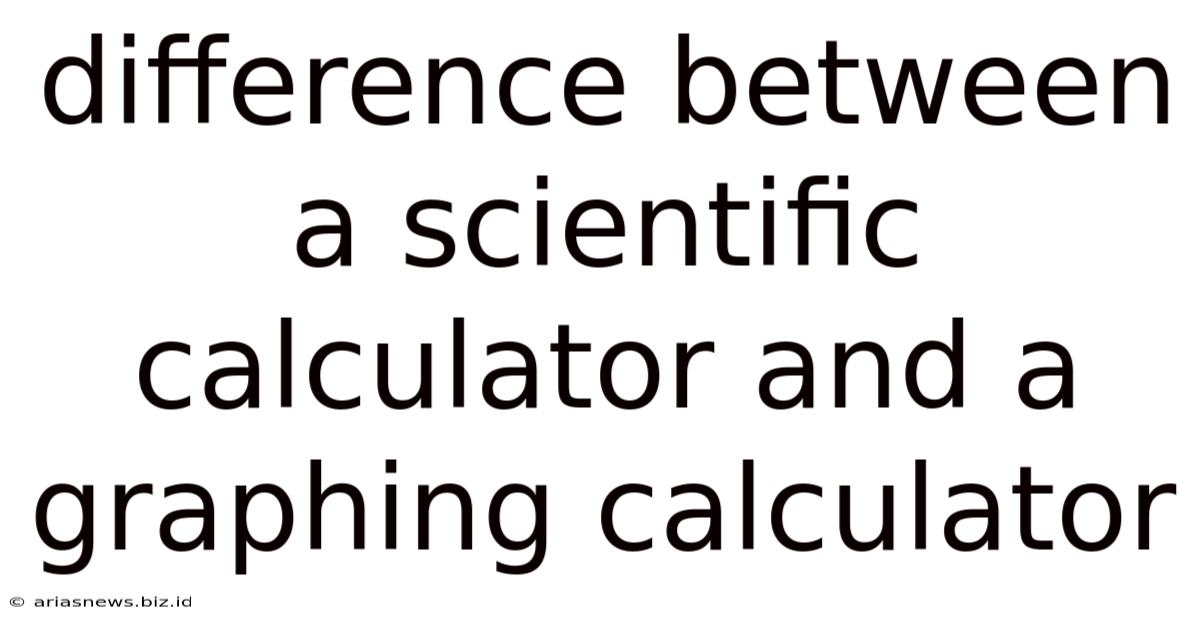Difference Between A Scientific Calculator And A Graphing Calculator
Arias News
May 11, 2025 · 4 min read

Table of Contents
Unveiling the Differences: Scientific vs. Graphing Calculators
Choosing the right calculator can significantly impact your academic success and overall efficiency. While both scientific and graphing calculators perform calculations, their functionalities and applications differ vastly. This comprehensive guide will delve into the core distinctions between these two types of calculators, clarifying their unique features and helping you decide which one best suits your needs. Understanding these differences is crucial for students, professionals, and anyone who relies on calculators for computation and analysis.
Core Functionality: A Fundamental Distinction
The most significant difference lies in their primary function. A scientific calculator excels at performing basic arithmetic operations (addition, subtraction, multiplication, division), advanced mathematical functions (trigonometry, logarithms, exponents), and statistical calculations. It provides a straightforward interface focused on delivering numerical results quickly and efficiently.
On the other hand, a graphing calculator offers all the capabilities of a scientific calculator but adds the crucial ability to visualize mathematical functions graphically. This graphical representation allows for a deeper understanding of mathematical concepts, enabling users to analyze trends, identify key features (like intercepts, maxima, and minima), and solve equations visually.
Feature Breakdown: A Detailed Comparison
Let's break down the features of each calculator type, highlighting their unique strengths and limitations:
Scientific Calculator Features:
- Basic Arithmetic: Addition, subtraction, multiplication, division, percentages.
- Advanced Functions: Trigonometric functions (sin, cos, tan), logarithmic functions (log, ln), exponential functions (e^x, x^y), square roots, powers, and factorials.
- Scientific Notation: Handles very large and very small numbers efficiently.
- Statistical Calculations: Mean, median, standard deviation, regression analysis (depending on the model).
- Memory Functions: Stores and retrieves values for later use.
- Unit Conversions: Some models offer built-in unit conversion capabilities.
- Compact Design: Typically smaller and more portable than graphing calculators.
- Lower Price Point: Generally more affordable than graphing calculators.
Graphing Calculator Features:
- All Scientific Calculator Functions: Includes all the features of a scientific calculator.
- Graphing Capabilities: Plots functions, equations, and inequalities on a coordinate plane.
- Table Generation: Creates tables of values for functions, aiding in analysis.
- Equation Solving: Solves equations and systems of equations numerically and graphically.
- Calculus Functions: Calculates derivatives and integrals (depending on the model).
- Statistical Analysis: Advanced statistical features, including hypothesis testing and probability distributions.
- Programming Capabilities: Some models allow for the creation of custom programs.
- Data Analysis: Enables the input and analysis of data sets, including regression analysis and statistical modeling.
- Larger Display Screen: Provides more space for viewing graphs and data.
- Higher Price Point: More expensive than scientific calculators due to their advanced features.
Practical Applications: Where Each Calculator Shines
The best calculator choice depends heavily on its intended use. Let's examine situations where each calculator type excels:
When to Use a Scientific Calculator:
- Basic Math and Science Classes: Ideal for introductory algebra, trigonometry, and basic science courses.
- Quick Calculations: Best for performing rapid calculations without needing graphical representation.
- Budget-Conscious Users: Provides essential functionality at a significantly lower cost.
- Standardized Tests (with restrictions): Many standardized tests allow only basic scientific calculators.
- Everyday Calculations: Suitable for everyday tasks such as calculating percentages, tips, or unit conversions.
When to Use a Graphing Calculator:
- Advanced Math and Science Courses: Essential for calculus, statistics, physics, and engineering courses.
- Visualizing Mathematical Concepts: Provides a powerful tool for understanding complex functions and their behavior.
- Solving Complex Equations: Effectively handles equations and systems of equations that are difficult to solve algebraically.
- Data Analysis and Modeling: Facilitates the analysis of large datasets and the creation of statistical models.
- Programming and Simulations: Allows for the creation of custom programs and simulations for various applications.
- AP and IB Exams: Often required or highly recommended for advanced placement and International Baccalaureate examinations.
Beyond the Basics: Advanced Considerations
Several additional factors can influence your decision:
Operating System and Software:
Graphing calculators often have their own operating systems and may offer downloadable applications or programs, expanding their capabilities. This flexibility isn't typically found in scientific calculators.
Memory and Storage:
Graphing calculators usually have significantly more memory than scientific calculators, allowing them to store more data, programs, and functions.
Connectivity:
Some graphing calculators offer connectivity options, enabling data transfer to and from computers or other devices.
Ease of Use:
While scientific calculators often boast simpler interfaces, more advanced features in graphing calculators can present a steeper learning curve. Consider your comfort level with technology when making your choice.
Conclusion: Making the Right Choice
The decision between a scientific and a graphing calculator boils down to your specific needs and the level of mathematical complexity you'll be dealing with. If you need a reliable tool for basic calculations and simple scientific functions, a scientific calculator will suffice. However, for advanced mathematics, data analysis, and graphical visualization, a graphing calculator is indispensable. By carefully considering the features, applications, and your individual requirements, you can confidently choose the calculator that will best support your academic and professional endeavors. Remember to also research specific models within each category, as features and capabilities can vary significantly between brands and models. Investing in the right calculator is an investment in your success.
Latest Posts
Latest Posts
-
How Can Metadata Help You Find Specific Data
May 11, 2025
-
Distance From Grand Rapids Mi To Kalamazoo Mi
May 11, 2025
-
I Was Born In 1975 How Old Am I
May 11, 2025
-
Distance From Austin Texas To Lubbock Texas
May 11, 2025
-
How Do You Say Good Morning My Love In Italian
May 11, 2025
Related Post
Thank you for visiting our website which covers about Difference Between A Scientific Calculator And A Graphing Calculator . We hope the information provided has been useful to you. Feel free to contact us if you have any questions or need further assistance. See you next time and don't miss to bookmark.